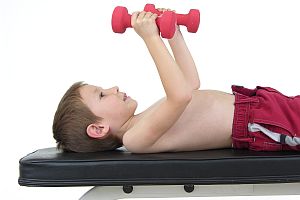Studies have shown that children who get sufficient amounts of regular physical activity each day are not only less likely to become obese, but show better attention and concentration in the classroom, behave better, and score higher on tests. But as important as physical education is for a child’s mental and physical development, the federal government has set no physical education curriculum standards and does not mandate the amount of time children must spend in physical activity. The government leaves it up to individual states and local school districts to decide on an appropriate physical education curriculum. Needless to say, this leads to a patchwork of approaches, some of which are more effective than others.
The government suggests that children get at least 60 minutes of physical exercise each day to maintain optimal health and establish good exercise habits that will hopefully continue throughout adulthood. However, only 74.5% of states require physical education in school from elementary school through high school. In addition, 28 states allow physical education exemptions and waivers, and schools are required to allot a specific amount of time for physical activity in only 22 states. Only New Jersey, Louisiana and Florida mandate the suggested minimum of 150 minutes per week of physical education in elementary school. And for high schools, only West Virginia, Utah and Montana mandate the recommended minimum of 225 minutes per week of physical education.
The Centers for Disease Control and Prevention stress the importance of children having access to high-quality physical education. The national standards can be found in the book by the National Association for Sport and Physical Education (NASPE), Moving Into the Future: National Standards for Physical Education. NASPE suggests that a basic physical education curriculum should incorporate the following 6 standards for a physically educated person:
Standard 1: Demonstrates competency in motor skills and movement patterns needed to perform a variety of physical activities.
Standard 2: Demonstrates understanding of movement concepts, principles, strategies, and tactics as they apply to the learning and performance of physical activities.
Standard 3: Participates regularly in physical activity.
Standard 4: Achieves and maintains a health-enhancing level of physical fitness.
Standard 5: Exhibits responsible personal and social behavior that respects self and others in physical activity settings.
Standard 6: Values physical activity for health, enjoyment, challenge, self-expression, and/or social interaction.
Many school systems have had their budgets cut so severely that they cannot afford to hire a full-time phys ed instructor. Schools can apply for funding grants for participation in the Presidential Youth Fitness Program, which sets out specific guidelines for getting kids fit. However, these are private grants and are not governmentally funded, so there is no guarantee of funding.
Participation in the Presidential Youth Fitness Program is voluntary, but the standards measured include aerobic capacity, body mass index, muscle strength, endurance and flexibility. The government is aiming to get as many schools as possible to follow the program to help ensure the nation’s children avoid the health problems that a sedentary lifestyle brings.

